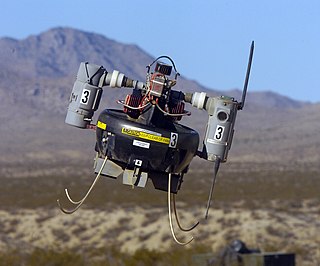
An unmanned aerial vehicle (UAV), commonly known as a drone, is an aircraft without any human pilot, crew or passengers on board. UAVs are a component of an unmanned aircraft system (UAS), which include additionally a ground-based controller and a system of communications with the UAV. The flight of UAVs may operate under remote control by a human operator, as remotely-piloted aircraft (RPA), or with various degrees of autonomy, such as autopilot assistance, up to fully autonomous aircraft that have no provision for human intervention.

A micro air vehicle (MAV), or micro aerial vehicle, is a class of miniature UAVs that has a size restriction and may be autonomous. Modern craft can be as small as 5 centimeters. Development is driven by commercial, research, government, and military purposes; with insect-sized aircraft reportedly expected in the future. The small craft allows remote observation of hazardous environments inaccessible to ground vehicles. MAVs have been built for hobby purposes, such as aerial robotics contests and aerial photography.

A miniature UAV, small UAV (SUAV), or drone is an unmanned aerial vehicle small enough to be man-portable.
Athena Technologies was a developer and manufacturer of control and navigation solutions for unmanned aerial vehicles (UAVs) and unmanned ground vehicles (UGVs). In April 2008, Athena was purchased by Rockwell Collins, Inc. for US$107 million.
Integrated Dynamics is a private company in Pakistan that designs, manufactures and exports various types of unmanned aerial vehicles (UAV). ID also provides consultancy and turn-key project commissioning for UAV systems.

Aurora Flight Sciences is an American aviation and aeronautics research subsidiary of Boeing which primarily specializes in the design and construction of special-purpose Unmanned aerial vehicles. Aurora has been established for 20+ years and their headquarters is at the Manassas Regional Airport in Manassas, Virginia.

The AeroVironment Wasp III Small Unmanned Aircraft System is a miniature UAV developed for United States Air Force special operations to provide a small, light-weight vehicle to provide beyond-line-of-sight situation awareness. The aircraft is equipped with two on-board cameras to provide real-time intelligence to its operators. It is also equipped with GPS and an Inertial Navigation System enabling it to operate autonomously from takeoff to recovery. It was designed by AeroVironment Inc., and was first added to the Air Force inventory in 2007. There are two Wasp variants: the traditional version that lands on land, and a version that lands into the sea or fresh water. The Air Force accepted the Wasp AE in late May 2012, and the U.S. Marine Corps revealed in January 2013 that they had ordered the Wasp AE. The Wasp AE is designated as the RQ-12A.
Ghatak is an autonomous stealthy unmanned combat air vehicle (UCAV), being developed by Aeronautical Development Establishment (ADE) of Defence Research and Development Organisation (DRDO) for the Indian Air Force. The design work on the UCAV is to be carried out by Aeronautical Development Agency (ADA). Autonomous Unmanned Research Aircraft (AURA) was a tentative name for the UCAV. Details of the project are classified.
ZALA Aero Group is a company specialising in unmanned aerial vehicle (UAV) development, located in Izhevsk, Russia. ZALA Aero has provided UAV systems for several sectors of the Russian government, including the Ministry of Defence, and has also won contracts to supply UAVs to foreign countries.
Paparazzi is an open-source autopilot system oriented toward inexpensive autonomous aircraft. Low cost and availability enable hobbyist use in small remotely piloted aircraft. The project began in 2003, and is being further developed and used at École nationale de l'aviation civile (ENAC), a French civil aeronautics academy. Several vendors are currently producing Paparazzi autopilots and accessories.

CATUAV S.L. is a technology-based private company that offers aerial services using unmanned aerial vehicles (UAV). Its headquarters are located in the Moià airfield in the BCN Drone Center, 40 km north of Barcelona, Spain.
ArduPilot is an open source, unmanned vehicle Autopilot Software Suite, capable of controlling autonomous:

A delivery drone is an unmanned aerial vehicle (UAV) used to transport packages, medical supplies, food, or other goods. Delivery drones are typically autonomous. In November 2020 the FAA proposed airworthiness criteria for type certification of delivery drones with an intent to initialize commercial operations. Zipline, Wingcopter, and Amazon Prime Air were amongst the 10 companies selected for this type certification.
The Bayraktar UAV or Bayraktar UCAV is a family of unmanned aerial vehicles designed and manufactured by Turkish company Baykar. Bayraktar series of UAVs are developed for Turkish Armed Forces, starting from 2004 up until today. While some models are intended purely for surveillance and reconnaissance, other are capable of ground-strike missions. Baykar is currently developing Bayraktars to be able to dogfight with other aerial vehicles and do air defence.

3DR is an American company headquartered in Berkeley, California that makes enterprise drone software for construction, engineering and mining firms, along with government agencies.
An autonomous aircraft is an aircraft which flies under the control of automatic systems and needs no intervention from a human pilot. Most autonomous aircraft are unmanned aerial vehicle or drones, however autonomous control systems are reaching a point where several air taxis and associated regulatory regimes are being developed.
A loitering munition is a weapon system category in which the munition loiters around the target area for some time, searches for targets, and attacks once a target is located. Loitering munitions enable faster reaction times against concealed or hidden targets that emerge for short periods without placing high-value platforms close to the target area, and also allow more selective targeting as the actual attack mission can be aborted.

The Wind Shadow and Cloud Shadow, also known as Wing Loong-10, is a series of unmanned aerial vehicles of the High-Altitude Long Endurance (HALE) type, featuring an stealthy air-frame. As of 2017 it is being developed by the Chengdu Aircraft Industry Group for reconnaissance and precision strike missions.








